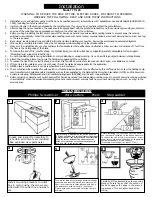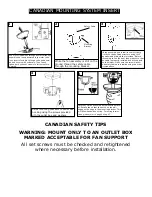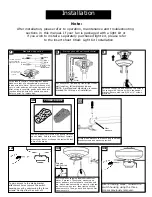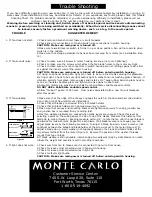
1.Check main and branch circuit fuses or circuit breakers.
2.Check line wire connections to fan and switch wire connections in switch housing.
CAUTION: Make sure main power is turned off.
3.Make sure forward/reverse switch is firmly in up or down position. Fan will not operate when
switch is in the middle.
4.Make sure that shipping stabilizer tabs have been removed from motor (see installation step
13).
1.Check to make sure all screws in motor housing are snug (not over tightened).
2.Check to make sure the screws which attach the fan blade holder to the motor are tight.
3.Check to make sure wire nut connectors in switch housing are not rattling against each other
or against the interior wall of the switch housing.
CAUTION: Make sure main power is turned off before entering switch housing.
4.If using an optional Ceiling Fan Light Kit, check to be sure the screws securing the glassware
are finger tight. Check to be sure light bulb is tight in socket and not touching glass shade(s). If
vibration persists from glass, remove glass and install a 1/4” wide rubber band on glass neck to
act as an insulator. Replace glass and tighten screws against rubber band.
5.Some fan motors are sensitive to signals from Solid State variable speed controls.
DO NOT USE a Solid State variable speed control.
6.Allow "break-in" period of 24 hours. Most noises associated with a new fan will disappear
after this period.
1.Make sure that the ridge of the canopy engages the notch in the downrod ball. (See illustra-
tion in Step #6 of Downrod Mount installation).
2.Check that all blades are screwed firmly into blade holders.
3.Check that all blade holders are tightened securely to motor.
4.Make sure that canopy and mounting bracket are tightened securely to ceiling junction box
and junction box is mounted firmly to ceiling joist.
5.Most fan wobble problems are caused when blade levels are unequal. Check this level by
selecting a point on the ceiling above the tip of one of the blades. Measure this distance from
blade tip to ceilng.(Figure 1) Keeping measure within 1/8", rotate the fan until the next blade is
positioned for measurement. Repeat for each blade. If all blade levels are not equal, you can
adjust blade levels by the following procedure. To adjust a blade tip down, insert a washer (not
supplied) between the blade and blade holder at the screw closest to the motor.(Figure 2) To
adjust a blade tip up, insert washer (not supplied) between the blade and blade holder at the
two screws farthest from the motor.(Figure 2) Reverse the position of the washer if blades
mount from top of blade.
6.If blade wobble is still noticeable, interchanging two adjacent (side by side) blades can redis-
tribute the weight and possibly result in smoother operation.
1.Check wire from fan to make sure it is connected to hot wire from house.
2.Check for loose or disconnected wires in fan switch housing.
3.Check for loose or disconnected wires in light kit.
4.Check for faulty light bulbs.
CAUTION: Make sure main power is turned off before entering switch housing.
2. If fan sounds noisy:
1. If fan does not start:
3. If fan wobbles:
4. If light does not work:
Trouble Shooting
If you have difficulty operating your new ceiling fan, it may be the result of incorrect assembly, installation, or wiring. In
some cases, these installation errors may be mistaken for defects. If you experience any faults, please check this Trouble
Shooting Chart. If a problem cannot be remedied, or you are experiencing difficulty in installation, please call our
Customer Service Center at the number printed on your parts list insert sheet.
Warning: Before servicing or cleaning unit, Switch power off at Service panel and lock service disconnecting
means to prevent power from being switched on accidentally. When the service disconnecting means cannot
be locked, securely fasten a prominent warning device, such as a tag, to the service panel.
Touching
Ceiling
Figure 1
Blade Tip Down:
Blade Tip Up:
Fan Blade
Fan Blade
Figure 2
Blade Brackets
Customer Service Center:
740 S.W. Loop 820, Suite 110
Fort Worth, Texas 76115
1-800-519-4092
TROUBLE
SUGGESTED REMEDY























